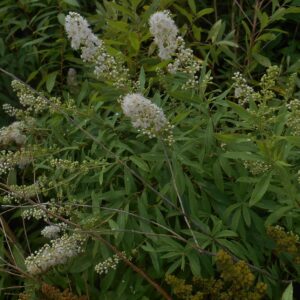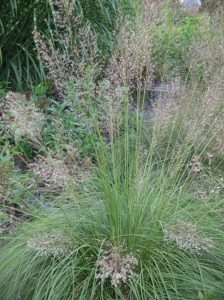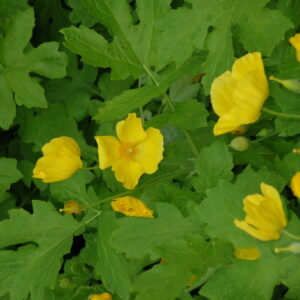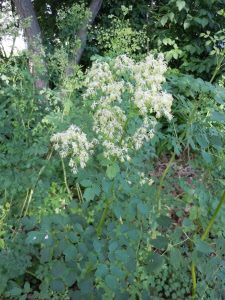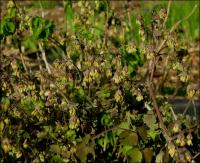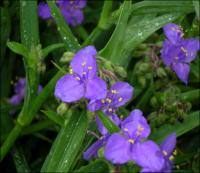Wisconsin Native
Showing 97–104 of 108 results
-
Spiraea alba Meadowsweet, Du Roi Z 3-7
This short shrub sports white flower spikes 4” long blooming from June to August, deadhead for rebloom.
This short shrub sports white flower spikes 4” long, blooming from June to August, deadhead for rebloom.
Size: 3-4’ x 3-4’
Care: sun to part shade in moist to moist well-drained soil
Native: Northeastern 2/3 of North America, Wisconsin native
Wildlife Value: nectar attracts butterflies & hosts caterpillars of Spring azure butterflies1st described in literature in 1772. Algonquin made a medicinal tea with Meadowsweet’s leaves and stems. Iroquois administered a decoction of mashed and powdered dry roots to remedy pain in the sides.
**LISTED AS OUT OF STOCK BECAUSE WE DO NOT SHIP THIS ITEM. IT IS AVAILABLE FOR PURCHASE AT OUR RETAIL LOCATION.
-
Sporobolus heterolepsis Prairie dropseed Zone 3 – 9
Mound of graceful thinnest of grass blades
The description in the Chiltern Seeds catalog cannot be improved: “This is the most elegant and refined of the North American prairie grasses …the finest texture composed of the thinnest of thin, thread-like, glossy green blades,.. in autumn turning deep orange before fading to a light copper for the winter. In late summer the plants bear, on very slender stalks high above the foliage, unbelievably delicate, graceful flower panicles, excellent for cutting. ”One of internationally known garden designer Piet Oudolf’s 100 “MUST HAVE” plants, Gardens Illustrated 94 (2013)
Size: 2’ x 2’
Care: Full sun in well-drained soil
Native: from Canada in the north to Texas in the south, Wisconsin native
Wildlife Value: seeds are food for birds
Awards: Missouri Botanic Garden Plant of Merit & Great Plants for Great Plains Grass of the Year.Sporobolos is Greek from sporo meaning seed and ballein meaning to cast forth because the seed readily falls from the flower (or dropseed, the common name). Ojibwa “Medicine Society” used roots to cure sores & “remove bile.”
-
Stylophorum diphyllum Celandine poppy Z 4-9
Sunny yellow cups bloom in late spring, reblooming sporadically, atop this 12-18" tall native.
OUT OF STOCK
Sunny yellow cups bloom in late spring, reblooming sporadically, atop this 12-18″ tall native.
Size: 12-18" x 12"
Care: Part shade, but tolerates sun, in moist to moist well-drained soil
Native: PA west to WI, south to MO & AK. Wisconsin native.1st collected by French plant hunter extraodinaire André Michaux, who spent 11 years in North America. (1746-1802) William Robinson, father of the mixed perennial border, described this as “a handsome Poppywort … (with) large bright yellow flowers freely produced in early summer.” Self-seeds and likely you’ll be happy for it.
-
Symphoricarpos albus Snowberry Z 3-7
Small pink bell-shaped flowers turn into copious clusters of round, white berries, like miniature snowballs, grace this shrub from late summer through winter.
OUT OF STOCK
Small pink bell-shaped flowers turn into copious clusters of round, white berries, like miniature snowballs, grace this shrub from late summer through winter.
Size: 3-6’ x 3-6’
Care: sun to part shade in moist well-drained to well-drained soil
Native: Canada east to west coasts; US all states north from Virginia to California. Wisconsin native.
Wildlife Value: deer tolerant, attracts numerous birds including Hummingbirds, Towhees, Grouses, Robins, and Waxwings for nesting and food, although the fruit is poison to humans. Bees flock to the flowers’ pollen. Host for caterpillars of the Snowberry Sphinx moth and Snowberry Clearwing moth.Pauites of Oregon constructed cradle boards with the wood, sharpened the stem for digging tool and used its branches in a game of dice. The Nez Perce boiled sticks in water then used to remedy fevers, and encircled its branches around cradleboards to protect babies from ghosts. Flathead cured injured eyes with juice for the fruit and made a paste of its fruit, bark and leaves to remedy skin ailments and burns. For the Blackfoot the smoke from burning twigs blackened newly made pipes. Sioux made a diauretic from the fruit. Ojibwa speeded up convalescence for new mothers after giving birth with water infused with this. Shoshone made arrows from shoots for small birds. Collected for botany before 1753. Also collected on Lewis and Clark Expedition along the Missouri River west of Council Bluffs.
**LISTED AS OUT OF STOCK BECAUSE WE DO NOT SHIP THIS ITEM. IT IS AVAILABLE FOR PURCHASE AT OUR RETAIL LOCATION.
-
Thalictrum dasycarpum Purple meadowrue Z 4-9
Panicles of delicate dangling ivory flowers May to July, purple stems
Panicles of delicate dangling ivory flowers May to July, purple stems.
Size: 4-5’ x 2’
Care: sun to part shade in moist well-drained to moist soil
Native: All North America except Atlantic & Pacific coasts and northern Canada, Wisconsin nativeThalictrum is from Greek meaning “to flourish” or “look green.” Collected for gardens by 1842. Used by Native Americans to enliven horses by giving them seeds or rubbing a poltice on their muzzles. (Pawnee & Lakota). Meskwaki, Ponca & Potawatomi used as an aphrodisiac. Potawatomi smoked a mixture of this and tobacco before meeting their woman. HoChunk used it to perfume smoke. For Potawatomi smoking dried seeds brought luck in hunting. Oneidas consider this a medication for kidney ailments. Ponca boys made flutes from the hollow stems. Winnebago perfumed smoke with this. Lakotaa Sioux fed this to horses to stimulate energy and masticated then rubbed it on their skin to repel insects.
-
Thalictrum dioicum Early meadowrue Z 5-9
Chartreuse blooms in spring
OUT OF STOCK
Hanging chartreuse blooms dangle from the stems in spring
Size: 20" x 24"
Care: shade to part shade in moist or moist well-drained soil.
Native: Quebec west to No. Dakota, south to Georgia, Wisconsin native
Wildlife Value: Attracts Black swallowtail butterfly. Deer resistant.Thalictrum is from Greek meaning “to flourish” or “look green.” Cherokee made an infusion of the root to cure nausea and diarrhea. Iroquois used it to remedy sore eyes and heart palpitations. The plant also would “make you crazy.” One of 1st No. American plants sent to Europe – grew in Tradescant the Elder’s South Lambeth nursery in 1634. Collected again by Rev. John Banister who moved to colonial Virginia in 1678. A gunman mistakenly shot and killed him while he collected plants. Scotsman Thomas Drummond collected this on the eastern base of the Rocky Mountains. Grown at America’s 1st botanic garden, Elgin Botanic Garden 1811.
-
Tradescantia bracteata Spiderwort Z 4-9
rosy purple flowers July-August
rosy purple flowers July-August
Size: 12-18” x 12”
Care: full sun to part shade in moist well drained soil
Native: Minnesota south to Texas
Wildlife Value: attracts bees & butterfliesGenus named after John Tradescant the Younger, an English botanist, who introduced Tradescantia virginiana to garden cultivation in 1637, when he sent it to his father, gardener to King Charles I. This prairie plant collected before 1938.
-
Tradescantia virginiana Spiderwort Z 4-9
Purple umbels with prominent yellow stamens June – October
Purple umbels with prominent yellow stamens June – October
Size: 18-24" x 24"
Care: Full sun to part shade in moist to moist well-drained soil
Native: From New York to South Dakota, Virginia and Arkansas
Wildlife Value: Bumblebees and honeybees eat the nectar and collect the pollen.Named after John Tradescant, an English botanist and gardener to King Charles I. Parkinson explains the origin of this plant: “This Spider-wort is of late knowledge, and for it the Christian world is indebted unto that painfull industrious searcher, and lover of all natures varieties, John Tradescant who first received it of a friend, that brought it out of Virginia,” (1639). It was probably sent to mainland Europe in 1500’s. Grown at America’s 1st botanic garden, Elgin Botanic Garden 1811. Tradescantia was cherished by the Dakota Indians for its beauty. Cherokee ate the young greens and prescribed it to cure stomachaches after overeating, female illnesses, cancer and insect bites. Menominee revived those “defiled by touch of bereaved.” Natives applied a poultice of the leaves topically for insect bites and stings. By 1659 ones with white, light blue and reddish flowers grown in England. According to Monticello.org the root exuded a gummy liquid which, when inserted into a cut on top of a person’s head remedied the person’s “craziness.” Cultivated in the U.S. since 1700’s

